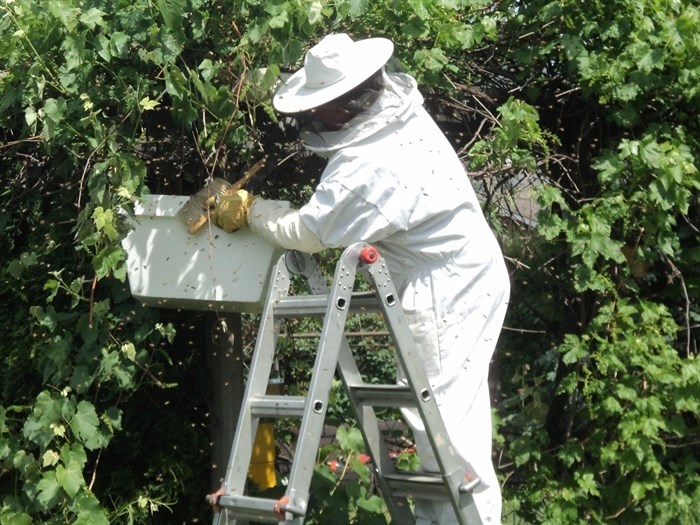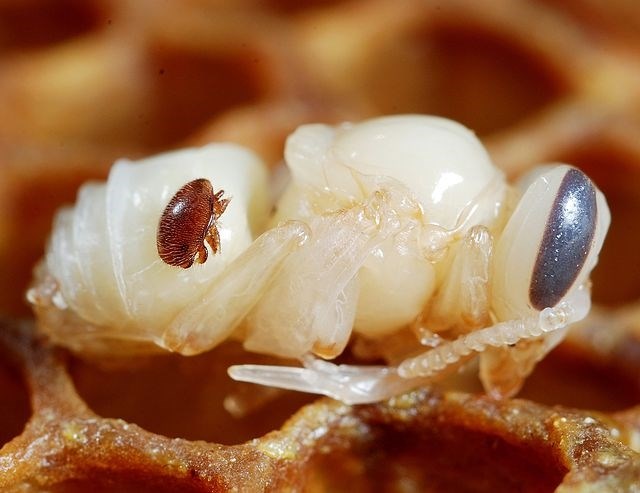
Kamloops beekeeper Murray Willis tending to his honeybees in spring, 2020.
Image Credit: SUBMITTED/ Murray Willis
August 14, 2022 - 6:55 AM
This year an extraordinary 45.5 per cent of the country’s overwintering honeybee colonies died.
Poor varroa mite control was cited as the biggest contributing factor, according to a recent report published by the Canadian Association of Professional Apiculturists.
“We were more fortunate in B.C. where 32 per cent of overwintering colonies died,” said provincial apiculturist Paul van Westendorp. “That sounds like a lot, but is pretty typical.”
The varroa mite is an external parasitic mite that attacks and feeds on some species of honey bees and is responsible for several debilitating bee viruses.
Van Westendorp said eliminating them is impossible because of physiological factors. The mites are able to adapt to the honeybee cycles and can also figure out how to metabolize chemical controls, making it difficult for beekeepers to effectively protect their colonies and requiring an integrated pest management approach.
“When you have an infection of some sort you go to the doctor and get an antibiotic prescription and the problem is solved, “he said. “The difference in terms of biological sophistication between us and a microbe is enormous. We apply a chemical to the microbe, it dies and we have the ability to break down the chemicals.
“The physiological sophistication difference between a honeybee and a Varroa mite is not that great.”
READ MORE: Penticton most crime ridden city in Thompson-Okanagan and much of B.C.
Van Westerndorp said specialists have been trying to find a chemical that is damaging to mites and benign to bees but this is very hard to do.
“The two organisms are so close together,” he said. “The mites are sophisticated pathogens and have managed to form a number of strategies to succeed. They synchronize their brood cycle with the honeybees to take full advantage of them.”

FILE PHOTO
Image Credit: WIKIMEDIA COMMONS/ Gillis San Martin
The mites live off the larva and pupa of bees and grow into adult mites, even feeding on the body fat of adult bees.
Van Westendorp said mites will inevitably learn how to adapt to chemical products, and there is not enough variety in the products available to get ahead of them.
“If we use a chemical to control the mites they will die and maybe some bees,” he said. “But at some point if we keep using the product out of the total population of mites one or two will figure out the chemical pathway and metabolize it. These mites survive, mate and produce resistant mites.”
READ MORE: How gardeners can control pests and also protect pollinators
There is not a linear approach for beekeepers to take to control the mites, it requires an integrated pest management approach.
“Because mites can synchronize their broods with honeybee broods, they can outsmart the beekeeper,” van Westendorp said. “For keepers to get good control of mites they must monitor frequently. They can’t wait until later in the season to apply control product. We can’t use a calendar based approach.”
It is recommended beekeepers apply control product in the spring and after honey production in the fall, and most years that is enough. But some years the application is too late or not synchronized with the mite population.
“Keepers basically have to get into the business of mite management,” van Westendorp said. “They will not get rid of them all but can manage the mite population by doing regular monitoring and tests from the early spring and throughout the season. Once a trend is apparent, they can apply controls."
Kamloops-based beekeeper Murray Willis suffered a 70 per cent loss of overwintering bees this year, the biggest loss he’s seen in years.
He believes Varroa mites and weather patterns were the biggest contributing factors in the late winter . He hasn’t done a recent test on his colonies but said the mite populations are typically high at this time of the year.
“I won’t treat the bees for mites until they are finished producing honey,” he said. “I treat with formic acid which some will say is organic and can be used during honey production, and maybe the amounts the bees carry in are miniscule but I don’t want it in my honey.”
Willis said mite management is continuous.
“They are like fleas on dogs,” he said. “You know they are going to be there so you manage the best you can.”
According to the national study, other factors contributing to the high amount of loss of overwintering honeybees were poor queens, weak colonies in the fall, weather and starvation.
For free and educational courses on honeybees offered by the B.C. Government click here.
To contact a reporter for this story, email Shannon Ainslie or call 250-819-6089 or email the editor. You can also submit photos, videos or news tips to the newsroom and be entered to win a monthly prize draw.
We welcome your comments and opinions on our stories but play nice. We won't censor or delete comments unless they contain off-topic statements or links, unnecessary vulgarity, false facts, spam or obviously fake profiles. If you have any concerns about what you see in comments, email the editor in the link above.
News from © iNFOnews, 2022